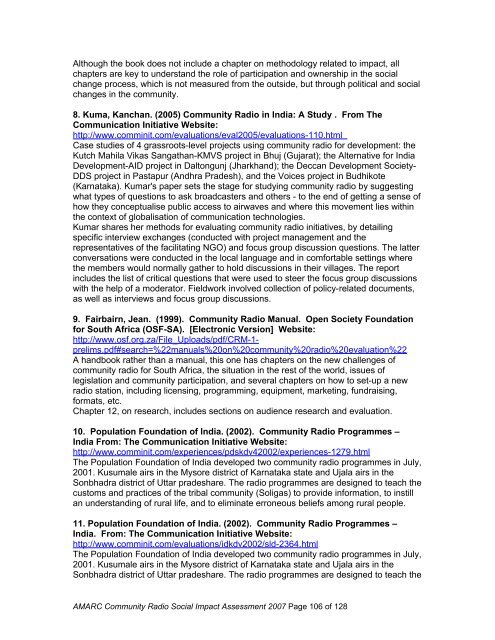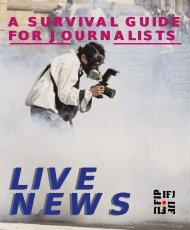Removing Barriers, Increasing Effectiveness - amarc
Removing Barriers, Increasing Effectiveness - amarc
Removing Barriers, Increasing Effectiveness - amarc
Create successful ePaper yourself
Turn your PDF publications into a flip-book with our unique Google optimized e-Paper software.
Although the book does not include a chapter on methodology related to impact, allchapters are key to understand the role of participation and ownership in the socialchange process, which is not measured from the outside, but through political and socialchanges in the community.8. Kuma, Kanchan. (2005) Community Radio in India: A Study . From TheCommunication Initiative Website:http://www.comminit.com/evaluations/eval2005/evaluations-110.htmlCase studies of 4 grassroots-level projects using community radio for development: theKutch Mahila Vikas Sangathan-KMVS project in Bhuj (Gujarat); the Alternative for IndiaDevelopment-AID project in Daltongunj (Jharkhand); the Deccan Development Society-DDS project in Pastapur (Andhra Pradesh), and the Voices project in Budhikote(Karnataka). Kumar's paper sets the stage for studying community radio by suggestingwhat types of questions to ask broadcasters and others - to the end of getting a sense ofhow they conceptualise public access to airwaves and where this movement lies withinthe context of globalisation of communication technologies.Kumar shares her methods for evaluating community radio initiatives, by detailingspecific interview exchanges (conducted with project management and therepresentatives of the facilitating NGO) and focus group discussion questions. The latterconversations were conducted in the local language and in comfortable settings wherethe members would normally gather to hold discussions in their villages. The reportincludes the list of critical questions that were used to steer the focus group discussionswith the help of a moderator. Fieldwork involved collection of policy-related documents,as well as interviews and focus group discussions.9. Fairbairn, Jean. (1999). Community Radio Manual. Open Society Foundationfor South Africa (OSF-SA). [Electronic Version] Website:http://www.osf.org.za/File_Uploads/pdf/CRM-1-prelims.pdf#search=%22manuals%20on%20community%20radio%20evaluation%22A handbook rather than a manual, this one has chapters on the new challenges ofcommunity radio for South Africa, the situation in the rest of the world, issues oflegislation and community participation, and several chapters on how to set-up a newradio station, including licensing, programming, equipment, marketing, fundraising,formats, etc.Chapter 12, on research, includes sections on audience research and evaluation.10. Population Foundation of India. (2002). Community Radio Programmes –India From: The Communication Initiative Website:http://www.comminit.com/experiences/pdskdv42002/experiences-1279.htmlThe Population Foundation of India developed two community radio programmes in July,2001. Kusumale airs in the Mysore district of Karnataka state and Ujala airs in theSonbhadra district of Uttar pradeshare. The radio programmes are designed to teach thecustoms and practices of the tribal community (Soligas) to provide information, to instillan understanding of rural life, and to eliminate erroneous beliefs among rural people.11. Population Foundation of India. (2002). Community Radio Programmes –India. From: The Communication Initiative Website:http://www.comminit.com/evaluations/idkdv2002/sld-2364.htmlThe Population Foundation of India developed two community radio programmes in July,2001. Kusumale airs in the Mysore district of Karnataka state and Ujala airs in theSonbhadra district of Uttar pradeshare. The radio programmes are designed to teach theAMARC Community Radio Social Impact Assessment 2007 Page 106 of 128
















